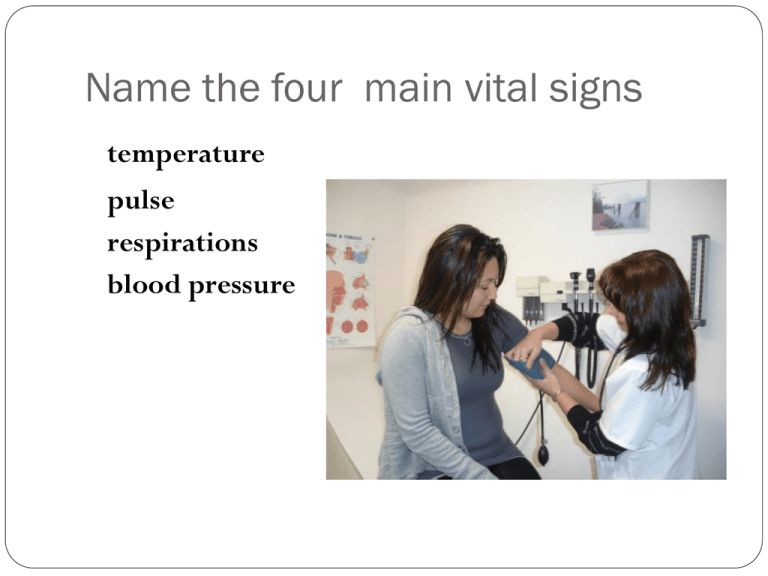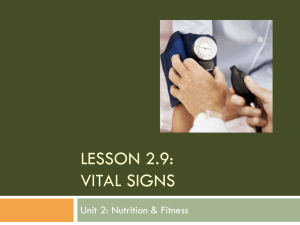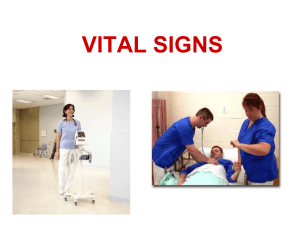Unit 14 Vital Signs
advertisement

Name the four main vital signs temperature pulse respirations blood pressure Unit 14 Vital Signs Measuring and Recording Vital Signs Why is it essential that vital signs are measured accurately? They are important indicators of the health state of the body. Main vital signs (VS) Temperature Pulse Respiration Blood pressure http://www.youtube.com/watch?v=f9OreW1n0qU Other Assessments Pain – patients asked to rate on scale of 1 to 10 (1 is minimal and 10 is severe) Color of skin Size of pupils and reaction to light Level of consciousness Response to stimuli Measuring Temperature Measures balance between heat lost and heat produced in the body. A high or low reading can indicate disease Normal temperature is 97.0 – 100.0F Five sites in the body where temperature can be measured are: Axillary (armpit) Oral Aural (ear) Rectal Temporal Measuring Pulse Pulse is the pressure of the blood felt against the wall of an artery as the heart contracts and relaxes, or beats. Pulse is usually taken over the radial artery. Any abnormality can indicate disease. The rate, rhythm, and volume are recorded Rate – number of beats per minute Rhythm – the regularity Volume – refers to the strength Measuring Pulse Pulse can be taken on several places Temporal – side of forehead Carotid – at the neck Brachial–inner aspect of the forearm at the crease of the elbow Radial- at the inner aspect of the wrist, above the thumb Femoral-inner aspect of the upper thigh Popliteal-behind the knee Dorsalis pedis-at the top of the foot arch Measuring Pulse – Rate Adults have a range of 60 – 90 beats per minute Children over 7 - a range of 70 – 90 beats per minute Children age 1 – 7 have a range of 80 – 110 Infants 100 – 160 beats per minute Any variation or extremes in pulse rate should be reported immediately Bradycardia is a pulse rate under 60 beats per minute Tachycardia is a pulse rate over 100 beats per minute (except in children) Measuring Pulse – Rhythm and Volume Rhythm refers to the regularity of the pulse or spacing of the beats. An arrhythmia is an irregular or abnormal rhythm, usually caused by a defect in the electrical conduction pattern of the heart. (prefix a- means without) Volume is the strength or intensity of the pulse. It is described as strong, weak, thready, or bounding Factors that can change pulse rate Pulse will be increased by: Pulse will be decreased by: Exercise Sleep Stimulant drugs Depressant drugs Excitement Heart disease Fever Coma Shock Physical training Nervous tension Apical Pulse The apical pulse is taken with a stethoscope at the apex of the heart. The actual heartbeat is heard and counted. An apical pulse is taken because of illness, hardening of the arteries, a weak and rapid pulse, or the patient is on heart medication. Because infants and small children have a rapid pulse, an apical pulse is always done. Apical Pulse An apical pulse is the heartbeat at the apex of the heart and is heard with a stethoscope. Apical Pulse When listening to the heart two sounds will be heard: lubb – dupp. Each lubb – dupp counts as one heart beat. The sound is caused by the closing of the heart valves as blood flows through the chambers of heart. If an abnormal sound is heard contact the provider. Measuring Respirations Respiration is the process of taking in oxygen and expelling carbon dioxide. Abnormal respirations indicate a health problem or disease. Three factors that are noted about respirations are the count, rhythm, and character. Count – the number of breaths Rhythm – the regularity of breaths Character – type of respirations Respirations - Rate The normal rate for respirations in adults is 14 - 18 breaths per minute In children, respirations are a little faster than adults, 16 -25 breaths per minute Infants the rate is between 30 – 50 breaths per minute Respirations – Character and Rhythm Character is the depth and quality of respirations. Character of respirations are described as Deep Shallow Labored Difficult Stertorous (abnormal, like snoring) Moist Rhythm is the regularity of the respirations. Rhythm is described as Regular irregular Respirations – Abnormal Dyspnea – difficult or labored breathing Apnea – absence of respirations Tachypnea – respirations over the normal range Bradypnea – respirations below the normal range Orthopnea – severe dyspnea in which breathing is very difficult in any position other that standing or sitting erect Cheyne - Stokes – periods of dyspnea followed by periods of apnea. Seen in dying patients Rales – bubbling or noisy sound caused by fluids or mucus in the air passages. Wheezing – Difficult breathing with high-pitched whistling or sighing sounds during expiration. Seen in persons with asthma Cyanosis – a dusky, bluish discoloration of the skin, lips, and nailbeds Measuring Blood Pressure Blood pressure is the force exerted by the blood against the arterial walls when the heart contracts and relaxes. Two readings noted on a blood pressure are systolic and diastolic Measuring Blood Pressure Systolic pressure is noted when the pressure is at its highest. Systolic pressure occurs in the walls of the arteries when the left ventricle of the heart is contracting and pushing blood through the arteries. Normal reading is 120mmhg. (range is 100 – 140 mmHg) Diastolic pressure is the noted when the pressure is at its lowest. Diastolic pressure is the constant pressure in the walls of the arteries when the left ventricle of the heart is at rest, or between contractions. A normal reading is 80mmHg (range of 60 – 90 mmHg) Blood Pressure Blood pressure is read using an stethoscope and a sphygmomanometer. Stethoscope is placed in ears and on the forearm in the antecubital space. The sphygmomanometer is placed one to one and one half inches above the elbow. Cuff is inflated to about 160mmHg. Listen for heart tones. First heart tone heard is the systolic pressure. The diastolic pressure is when the heart tone can no longer be heard. Abnormal Blood Pressure readings Hypertension – is high blood pressure (greater than 140 systolic and 90 diastolic) and can be caused by stress, anxiety, obesity, high salt intake, aging, kidney disease, thyroid deficiency, and vascular conditions such as arteriosclerosis. Hypotension –low blood pressure, can be caused by heart failure, depression, severe burns, hemorrhage, and shock. Orthostatic hypotension, occurs when there is a sudden drop in both systolic and diastolic pressures when a person moves from lying or sitting to a standing position. Factors that influence blood pressure Factors that may increase BP are: Excitement Anxiety Nervous tension Stimulant drugs Exercise Eating Smoking Factors that can influence BP Factors that may decrease blood pressure are Rest or sleep Depressant drugs Shock Excessive blood loss Fasting Changes in body position









